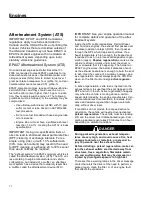
speed, makes the engine brake more effective. Rec-
ommended engine braking speed is above 1800 rpm
and below the rated speed.
WARNING
The engine brake must be disengaged when
shifting gears using the clutch pedal. If the en-
gine brake is engaged when the transmission is
in neutral, the braking power of the engine brake
can stall the engine, which could result in loss of
vehicle control, possibly causing personal injury
and property damage.
NOTICE
Do not allow the engine to exceed 2500 rpm. Se-
rious engine damage could result.
"Control speed" is the speed at which the engine
brake performs 100 percent of the required downhill
braking, resulting in a constant speed of descent.
The control speed varies, depending on vehicle
weight and the downhill grade.
For faster descent, select a higher gear than that
used for control speed. Service brakes must then be
used intermittently to prevent engine overspeed and
to maintain desired vehicle speed.
A driver may descend slower than control speed by
selecting a lower gear, being careful not to over-
speed the engine. Occasional deactivation of the en-
gine brake may be necessary to maintain the desig-
nated road speed under these conditions.
Below a set engine temperature when the engine is
cold, the brake may be disabled depending on the
brake type.
To activate the engine brake after the engine is
warmed up and the vehicle is in motion:
•
Remove your feet from both the clutch and
throttle pedals. Press the dash-mounted ENG
BRK switch to toggle the engine brake ON.
The engine brake will engage at the rate last
set on the brake intensity switch.
•
Move the intensity switch to the desired inten-
sity. Depending on engine model, LO will pro-
vide 1/3 or 1/2 of the full braking capacity of
the engine. HI will provide maximum engine
braking.
Use the dash-mounted switch set at the LO
position when driving on flat, open stretches of
road. If the service brakes are still required to
slow down on a grade, switch to a higher set-
ting on the dash switch, until there is no need
for the service brakes. Grade descent speed
should be such that the service brakes are
used infrequently and that they remain cool,
thus retaining their effectiveness.
•
For maximum retarding, maintain the top gov-
erned speed of the engine through the appro-
priate selection of gears. When shifting gears,
the engine brake will disengage when the
clutch pedal is depressed, then engage when
the clutch pedal is released.
•
To cancel the engine brake application, toggle
the ENG BRK switch OFF.
If the engine is equipped with both cruise control and
an engine brake, the engine brake can operate auto-
matically while in cruise control mode. If the cruise
control/engine brake function is turned on in the
DDEC VI system programming, the engine brake will
come on "low" when the set road speed increases a
few miles-per-hour (kilometers-per-hour) above the
cruise set speed. The maximum amount of braking
(low, medium, high) is selected with the dash
switches. When the vehicle returns to the set cruise
speed, the engine brake will turn off.
The engine brake will only operate when the accel-
erator pedal is fully released. Disengaging the clutch
will prevent the engine brake from operating.
Vehicles equipped with antilock braking systems
(ABS) have the ability to turn the engine brake off if
a wheel-slip condition is detected. The engine brake
will automatically turn itself back on once the wheel
slip is no longer detected. The DDEC VI system will
deactivate the engine brake system when the engine
speed falls below 1000 rpm or when the vehicle
slows down to a preset speed, depending on DDEC
programming. This prevents stalling the engine.
Exhaust Braking Systems
Exhaust Brake Switch
The optional exhaust brake is controlled by a dash-
mounted rocker switch to help slow the vehicle when
the accelerator is released.
Engines
7.15




























